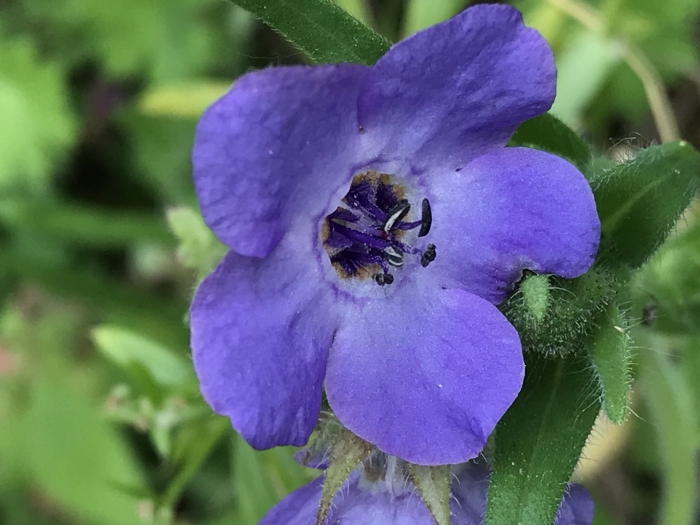Blue Fiestaflower
(Pholistoma auritum)
Blue Fiestaflower (Pholistoma auritum)
/
/

rappman
CC BY 4.0
Image By:
rappman
Recorded By:
Copyright:
CC BY 4.0
Copyright Notice:
Photo by: rappman | License Type: CC BY 4.0 | License URL: http://creativecommons.org/licenses/by/4.0/ | Rights Holder: rappman | Publisher: iNaturalist | Date Created: 2017-04-24T17:24:28Z |




















































Estimated Native Range
Summary
Pholistoma auritum, commonly known as Blue Fiestaflower, is an annual herb in the borage family, native to the chaparral, coastal sage scrub, and oak woodlands of California, Arizona, and Baja California. It is adapted to a Mediterranean climate with wet winters and dry summers. The plant typically grows to a height of 20-60 centimeters with a brittle, fleshy, bristly stem that branches profusely, sometimes forming a dense tangle. The leaves are deeply lobed and toothed, borne on winged petioles, and the foliage is coated in hairs and bristles, giving it a rough texture. The inflorescence consists of one or more bell-shaped flowers, each up to 1.5 centimeters long and 3 centimeters wide, with hair-lined blue to purple petals and darker markings in the centers. The flowering season is from February to May, and the flowers are moderately showy, attracting pollinators such as bees.
Blue Fiestaflower is valued for its unique foliage and delicate flowers, which add color and texture to wildflower gardens, native plant landscapes, and informal borders. It is often used to create a naturalized setting or as part of a pollinator garden. In cultivation, it thrives in full sun to part shade, requires medium amounts of water, and prefers well-drained soils. It is relatively easy to grow from seed and can reseed itself in suitable conditions. However, it is not widely available in the nursery trade and may need to be grown from wild-collected seed. While generally pest-free, it can be susceptible to powdery mildew in humid conditions.CC BY-SA 4.0
Blue Fiestaflower is valued for its unique foliage and delicate flowers, which add color and texture to wildflower gardens, native plant landscapes, and informal borders. It is often used to create a naturalized setting or as part of a pollinator garden. In cultivation, it thrives in full sun to part shade, requires medium amounts of water, and prefers well-drained soils. It is relatively easy to grow from seed and can reseed itself in suitable conditions. However, it is not widely available in the nursery trade and may need to be grown from wild-collected seed. While generally pest-free, it can be susceptible to powdery mildew in humid conditions.CC BY-SA 4.0
Plant Description
- Plant Type: Herb, Vine
- Height: 1.5-4 feet
- Width: 0.3-0.7 feet
- Growth Rate: Moderate
- Flower Color: Blue, Pink, Purple
- Flowering Season: Winter, Spring
- Leaf Retention:
Growth Requirements
- Sun: Full Sun, Part Shade
- Water: Medium
- Drainage: Medium
Common Uses
Bee Garden, Butterfly Garden, Low Maintenance, Potted Plant, Showy Flowers
Natural Habitat
native to the chaparral, coastal sage scrub, and oak woodlands of California, Arizona, and Baja California
Other Names
Common Names:
Scientific Names: , Pholistoma auritum, Pholistoma auritum var. auritum, Nemophila aurita, Ellisia aurita, Viticella aurita,
GBIF Accepted Name: Pholistoma auritum (Lindl.) Lilja ex Lindl.